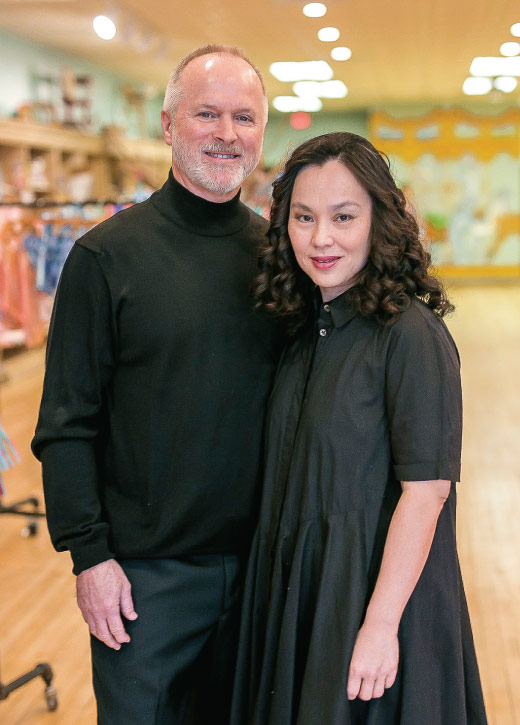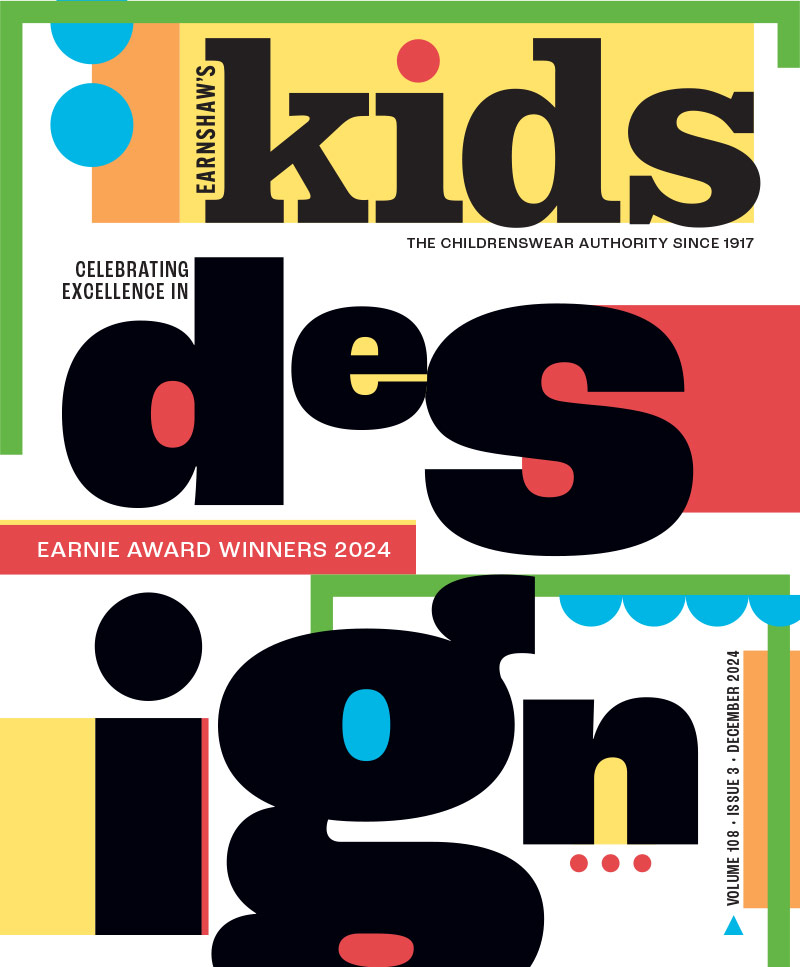Joy Cha and William Banti, owners of Lemon Loves Lime, share the foundation for their strong business is their even stronger relationship.

William Banti and Joy Cha
Joy Cha, born in Taiwan and raised in Flushing, Queens, grew up chasing the classic American dream. Her parents of Chinese descent had emigrated to the United States in 1979, sent Cha to Parsons School of Design and the Fashion Institute of Technology (FIT) and subsequently saw their daughter move to Paris for three years—an experience that, despite being “so poor,” Cha still remembers as one of the best times of her life.
William Banti, hailing from America’s Midwest as the youngest of five children, grew up in Franklin Park, Ill., (a stone’s throw away from O’Hare Airport in Chicago). One of his fondest memories of childhood is cooking with his mom, initially having the desire to get into the culinary arts. However, a career in marketing, sales and finance ultimately beckoned.
Chat Room
What kind of books do you like to read?
William: Spiritual books. The Power of Now and A New Earth by Eckhart Tolle. [Joy] likes to play the audio books before we go to bed to relax our minds. It puts us in a tranquil state to drift off.
Why do you believe you were a couple in a former life?
Joy: We think the same. We say the same thing at the same time.
William: We call each other at the exact same time.
What’s your favorite childhood memory?
Joy: When I was in third grade, I found a kitten starving on the street on my way home from school. I picked up the kitten and put her in my lunch box, I took her home, gave her a bath, killed all the fleas, then I fed her. Every time my mom came into my room, I hid her in my closet. That didn’t last long. I was on my knees begging my mom to keep the kitten. For a while, I was my kitten’s mommy. A few months later, I found her an adopted home.
William: I grew up with dogs my whole life, and I raised rabbits. I started out with one, and then my brother bought me a mate. Before I knew it, I had more than 30 rabbits.
Joy: Now we adopt dogs, and when we retire I want to adopt senior dogs. When animals feel comfortable and happy, I’m happy.
Who is your favorite historical character and why?
Joy: Elsa Schiaparelli. With no background of making garments, she used her vision to drape fabric on a form to create amazing unique looks that has had such an impact on fashion.
Years later, after divorces, children (Cha gave birth to Kaitlyn while Banti fathered Katie, Marcie and Bianca) and careers, the two met online, quickly fell in love and struck up a six-month long-distance relationship.
“It was the strangest experience for both of us,” says Cha, recalling the early days of their relationship. “We feel that we were a couple in a former life. We are so much alike.”
In the meantime, Cha had started Lemon Loves Lime, a collection of boys’ and girls’ childrenswear inspired by her daughter. It didn’t take long for Cha to marry Banti, and consequently move her daughter and her business to Chicago. It was only a short time before Banti started playing a more active role in Lemon Loves Lime.
Now the two are celebrating the company’s 10th birthday and appear to have dovetailed as effortlessly professionally as they did personally. Indeed, talking to the couple is like talking to one person. They finish each other’s sentences, value the same kind of childhood memories and believe in the same business philosophy—that is, to build relationships for the long haul, not just for the quick sale. The two also believe in creating high quality childrenswear, pieces that can be handed down from sibling to sibling.
Sticking to their deep-seated values hasn’t always been easy, they say, but in the end, it has proved gratifying both privately and at work.
How did you get into the childrenswear business?
Joy: My parents ran away from the communists, and we moved to New York. My mother was working as a knitter, so I grew up in this world. At 13, I started to gather up pieces of yarn from my mom’s excess scraps, and I used these scraps to machine-knit and crochet tiny dresses, scarves, hats and skirts for my Barbie dolls. Three years later, my mom started her own knit studio and, at 17, I was knitting my own sweaters. At age 19, I was working for my mom as a professional sample maker. I went to Parsons and FIT and in 2007 the company that I worked for for nine years as head designer began going downhill. I was laid off because I was the highest paid. I had started my own collection on the side, already planting seeds. This was the turning point in my life that opened the door for me to begin my journey into childrenswear. My daughter Kaitlyn was just two years old, and the inspiration for Lemon Loves Lime because I fought for more than six years to conceive her.
What does the name Lemon Loves Lime refer to?
Joy: I was trying to come up with a brand name for a week, then one morning on my way to work, my daughter pointed her little finger to a picture and said ‘Mommy, look, lemon, Mommy, lime.’ Her little voice kept repeating in my ears when I was on the Long Island Rail Road. I thought about how much I love my daughter and put that love in the middle of the name. Lemon Loves Lime was born.
Then you met William the following year in 2008?
William: Yes, I’d been working in the direct mail industry. I was working on finance, marketing and sales. That was my background. I’m very fortunate because my daughter Katie at that time was working for United Airlines as a flight attendant, and one day she said, ‘You know, Dad, parents can fly using my benefits.’ And I said, ‘Oh, really?’ I never thought about it until I met Joy, and then all of a sudden I said, ‘Katie, I think I’m going to take advantage of your airfare.’ Every Friday when I left work, I basically had my bags packed and went to the airport. For about six months, I traveled back and forth from Chicago to New York every weekend to visit her.
When did it morph into a professional connection?
William: In late 2008. I watched Joy for a long time, watched how she was struggling. She was running everything out of her house. She had boxes everywhere lined up against the perimeter of the wall. The living room was the warehouse, her dining room was the office and the kitchen was the shipping area.
Joy: It was a tiny home in Queens with a child, a dog and a cat running rampant.
William: She did a great job. She worked hard, and I said, ‘I’ll help you if you want.’ I think Joy was comfortable with what she was doing, and she was happy doing what she was doing. She had a good little base of customers, and she had one sales rep in Dallas. At that point, I thought Joy needed to consider taking it to the next level, and at least put the whole operation into a real work environment.
Joy: We quickly realized that we needed to simplify our lives, and I made the decision to move to Chicago. [William] found a 1,000-square-foot space in Illinois. Then we moved to a larger operation, a real warehouse and office area in Carol Stream. This past April, we moved that operation to Wisconsin.
William: I took an early retirement in May of 2011 because of all the phone calls, the texts, the emails…
Joy: And the crying.
William: And the crying. It was getting to be too much. We had some good people, but I think Joy was overwhelmed. She just had too much on her plate. It’s tough to be designing three collections and trying to run everything else. I took over the warehouse operations and tried to help with customer service and took over all the accounting functions.
What are you most proud of accomplishing in your business since those early days?
William: We’re very concerned with quality. My trips [to Peru] basically involve doing the quality control checks, so I’m measuring, snapping pictures, comparing dye lots, and I’m just making sure that everything’s up to snuff.
How do you reconcile good quality with the pressure to lower prices?
William: Joy and I have seen this big change from 2007 to now where quality was very important early on. I think back in the ’80s, ’90s and early 2000s, everybody was focused on quality. But after the economic crash, I think people tended to focus more on price.We were worried because we didn’t want to diminish what we’ve done all these years. Our brand is all about quality and making a high-end product, and we didn’t want to change any of that. Most of our clothing is done in 100-percent cotton and Pima cotton. Cotton prices tripled over a period of two years. But we didn’t change. A lot of companies changed the blend of their fabrics because of that. We never did. We stuck with it. We absorbed the losses and stayed true to who we were.
Do you think customers appreciated the standard of quality you upheld?
William: They did. They really did. That was a period when our company really blossomed, really grew strong. Then we saw a lot of companies move production to India to lower their costs. We didn’t want to do that. We knew how strong and how good the quality of the product was that we were producing in Peru. We stuck with it. It was tough. I was worried the bottom line was going to hurt, but in the long run we actually grew our customer base.
Joy: In Europe, a lot of designers want cheaper material. The designs are beautiful, but after a couple of washes, they disintegrate. Our garments can be passed down. Customers don’t throw it away. They give it to their siblings.
How do you change with the ebbs and flow of business?
William: We’re constantly negotiating. Our company’s always updating technology. We went to an automated ordering system, a paperless environment. We’ve looked into social responsible ways to make our clothing. Everything we do right now is natural. Even the dyes we use are eco-friendly. We even explored the organic market a little bit, but we didn’t think it was a good fit for us at this point.
What inspires your clothing designs from season to season?
Joy: I do a lot of research looking for something that hasn’t been designed. Besides the ocean group, I do mermaids every season, but she’s a different mermaid. She does different things. I always try to put a story together. I could be inspired by a painter or a story or just a beautiful picture. I collect most of my images online, and I put together the feeling and the color palette that I like. I don’t repeat the same color much and I don’t really follow the trends much. I have my own system, my formula.
You mentioned you bring back sea creatures in every season. Why?
Joy: It’s an ode to someone I lost in my life. He was my mentor and introduced me to the buyer of Cole’s of Nassau in the Bahamas. As a well-known handbag designer, he was known for his sea creatures and ocean themes. He was murdered by somebody who hated him. It was devastating.
What categories are you expanding going forward?
Joy: Lemon Loves Layette. We grade it as the finest Pima cotton. It’s 70 stitches per inch. It’s very technical, and very fine. We’ve created a beautiful layette collection in solid colors. We stand out from other companies because a lot of companies do layettes in print. Because the fabric colors are so vibrant, the only embellishments are ruffles and beautiful shapes for gowns, dresses, rompers and even bibs. We ship all year around. People are constantly asking for reorders. We used to fill about 10 to 20 percent of our warehouse with the layette collection and now it fills 50 percent of our warehouse. I do add new colors every season to keep it fresh and I think it’s time to expand this collection.
You opened a retail store in Menasha, Wisc., two years ago. How has that helped you understand the customer?
Joy: I talk to a lot of customers. A few times, I caught myself chatting with them for over an hour, and I go, ‘I have to go back to work.’ They share really fun stories and good ideas, and say, ‘Do this, do that and don’t forget to do the same great dress again next season.’ Additionally, I’m involved in customer service and returns.
William: We opened up our first retail for two reasons. There was a revitalization effort going on here in this town, and we wanted to be a part of that. Then also, we wanted to learn from it because we thought this would be a better connection for our customers, a way we can relate to them more.
In the store, do you carry other brands other than Lemon Loves Lime?
Joy: Yes. Mainly accessories—Aden + Anais, Mini Melissa and Livie & Luca. Plus, we do toys—Melissa & Doug toys.
Describe the experience in the store.
Joy: We have an ice cream parlor in our store. That’s Bill’s baby. Kids love that, and they’re pretty good at not walking around with the ice cream. We have a play area in the back. When moms and grandmoms come in, the kids go and play. After the moms and grandmoms check out the clothes, they take the kids to the ice cream parlor.
What else has running a retail store taught you about
your business?
William: We concentrate on great customer service. We make them feel like we are here to help, not just pushing for the sale.
You are also expanding into ecommerce, correct?
Joy: We just started to design our website this year for the retail store.
William: We have landing pages for every brand. We use social media for all our brands and the retail store, but we’re working on the ecommerce site right now. Joy wants to keep it special. She wants to carry specialty items, some unique things. We don’t want to create conflict or competition with our existing customers.
Joy: I am developing designs with my factory in Peru. For instance, they’ve been knitting me dolls and making me hats specially for the store. I also did a 36-inch doll for my window display.
How do you see retail shifting in the future?
Joy: In our own retail store, the young parents come in, and they have their iPhones on them—price-shopping. They’re wondering what stores are carrying a particular product and are they getting the best deal. That’s what goes through their minds. Retail is a lot more than making your store beautiful.
William: I think a lot of retail stores need to be very careful about the brands that they carry because if it’s something they can find anywhere, if it’s saturating the market, then consumers are going to be more price-conscious. We’ve always tried to keep Lemon Loves Lime special and…
Joy: Exclusive.
William: I guess in the beginning, it was all about, ‘Let’s grow, grow, grow.’ But now we’re more focused on our loyal customer base and what we can do for them and how we can make new retail customers successful.
What do you love most about your careers?
William: We always have a list of things that we’re going to try and accomplish for the day, and we feel good at the end of the day because we tend to get most of it completed.
Joy: And then we walk upstairs to our retail store, and we meet interesting people and see kids running around.
William: We’re lucky. We can go up one flight of stairs and start meeting people who are coming into the store. I personally like to see the smile on kids’ faces when they come in the door.



Leave a Comment: